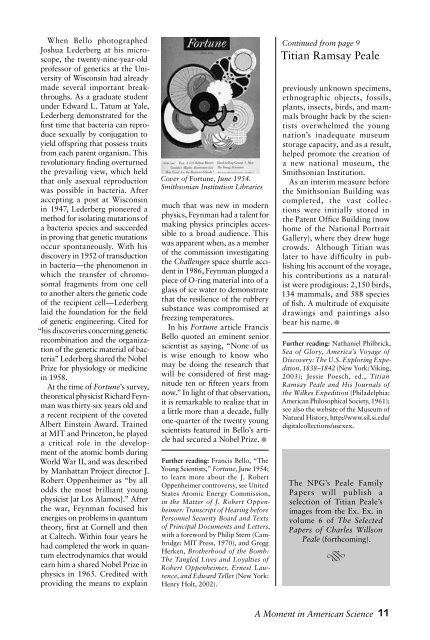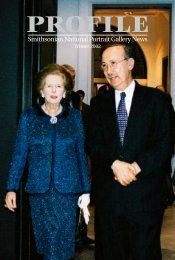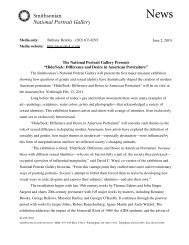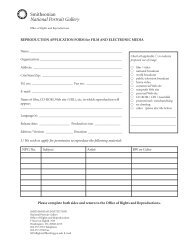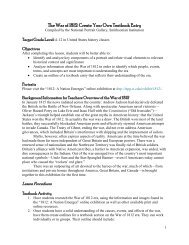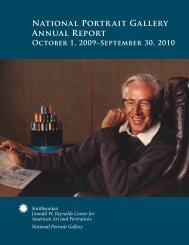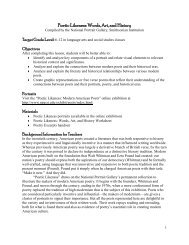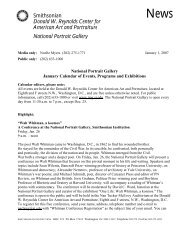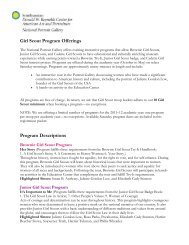Cambridge, Mass.: Da Capo Press, 2003 - National Portrait Gallery ...
Cambridge, Mass.: Da Capo Press, 2003 - National Portrait Gallery ...
Cambridge, Mass.: Da Capo Press, 2003 - National Portrait Gallery ...
Create successful ePaper yourself
Turn your PDF publications into a flip-book with our unique Google optimized e-Paper software.
When Bello photographed<br />
Joshua Lederberg at his microscope,<br />
the twenty-nine-year-old<br />
professor of genetics at the University<br />
of Wisconsin had already<br />
made several important breakthroughs.<br />
As a graduate student<br />
under Edward L. Tatum at Yale,<br />
Lederberg demonstrated for the<br />
first time that bacteria can reproduce<br />
sexually by conjugation to<br />
yield offspring that possess traits<br />
from each parent organism. This<br />
revolutionary finding overturned<br />
the prevailing view, which held<br />
that only asexual reproduction<br />
was possible in bacteria. After<br />
accepting a post at Wisconsin<br />
in 1947, Lederberg pioneered a<br />
method for isolating mutations of<br />
a bacteria species and succeeded<br />
in proving that genetic mutations<br />
occur spontaneously. With his<br />
discovery in 1952 of transduction<br />
in bacteria—the phenomenon in<br />
which the transfer of chromosomal<br />
fragments from one cell<br />
to another alters the genetic code<br />
of the recipient cell—Lederberg<br />
laid the foundation for the field<br />
of genetic engineering. Cited for<br />
“his discoveries concerning genetic<br />
recombination and the organization<br />
of the genetic material of bacteria”<br />
Lederberg shared the Nobel<br />
Prize for physiology or medicine<br />
in 1958.<br />
At the time of Fortune’s survey,<br />
theoretical physicist Richard Feynman<br />
was thirty-six years old and<br />
a recent recipient of the coveted<br />
Albert Einstein Award. Trained<br />
at MIT and Princeton, he played<br />
a critical role in the development<br />
of the atomic bomb during<br />
World War II, and was described<br />
by Manhattan Project director J.<br />
Robert Oppenheimer as “by all<br />
odds the most brilliant young<br />
physicist [at Los Alamos].” After<br />
the war, Feynman focused his<br />
energies on problems in quantum<br />
theory, first at Cornell and then<br />
at Caltech. Within four years he<br />
had completed the work in quantum<br />
electrodynamics that would<br />
earn him a shared Nobel Prize in<br />
physics in 1965. Credited with<br />
providing the means to explain<br />
Cover of Fortune, June 1954.<br />
Smithsonian Institution Libraries<br />
much that was new in modern<br />
physics, Feynman had a talent for<br />
making physics principles accessible<br />
to a broad audience. This<br />
was apparent when, as a member<br />
of the commission investigating<br />
the Challenger space shuttle accident<br />
in 1986, Feynman plunged a<br />
piece of O-ring material into of a<br />
glass of ice water to demonstrate<br />
that the resilience of the rubbery<br />
substance was compromised at<br />
freezing temperatures.<br />
In his Fortune article Francis<br />
Bello quoted an eminent senior<br />
scientist as saying, “None of us<br />
is wise enough to know who<br />
may be doing the research that<br />
will be considered of first magnitude<br />
ten or fifteen years from<br />
now.” In light of that observation,<br />
it is remarkable to realize that in<br />
a little more than a decade, fully<br />
one-quarter of the twenty young<br />
scientists featured in Bello’s article<br />
had secured a Nobel Prize.<br />
Further reading: Francis Bello, “The<br />
Young Scientists,” Fortune, June 1954;<br />
to learn more about the J. Robert<br />
Oppenheimer controversy, see United<br />
States Atomic Energy Commission,<br />
in the Matter of J. Robert Oppenheimer:<br />
Transcript of Hearing before<br />
Personnel Security Board and Texts<br />
of Principal Documents and Letters,<br />
with a foreword by Philip Stern (<strong>Cambridge</strong>:<br />
MIT <strong>Press</strong>, 1970), and Gregg<br />
Herken, Brotherhood of the Bomb:<br />
The Tangled Lives and Loyalties of<br />
Robert Oppenheimer, Ernest Lawrence,<br />
and Edward Teller (New York:<br />
Henry Holt, 2002).<br />
Continued from page 9<br />
Titian Ramsay Peale<br />
previously unknown specimens,<br />
ethnographic objects, fossils,<br />
plants, insects, birds, and mammals<br />
brought back by the scientists<br />
overwhelmed the young<br />
nation’s inadequate museum<br />
storage capacity, and as a result,<br />
helped promote the creation of<br />
a new national museum, the<br />
Smithsonian Institution.<br />
As an interim measure before<br />
the Smithsonian Building was<br />
completed, the vast collections<br />
were initially stored in<br />
the Patent Office Building (now<br />
home of the <strong>National</strong> <strong>Portrait</strong><br />
<strong>Gallery</strong>), where they drew huge<br />
crowds. Although Titian was<br />
later to have difficulty in publishing<br />
his account of the voyage,<br />
his contributions as a naturalist<br />
were prodigious: 2,150 birds,<br />
134 mammals, and 588 species<br />
of fish. A multitude of exquisite<br />
drawings and paintings also<br />
bear his name.<br />
Further reading: Nathaniel Philbrick,<br />
Sea of Glory, America’s Voyage of<br />
Discovery: The U.S. Exploring Expedition,<br />
1838–1842 (New York: Viking,<br />
<strong>2003</strong>); Jessie Poesch, ed., Titian<br />
Ramsay Peale and His Journals of<br />
the Wilkes Expedition (Philadelphia:<br />
American Philosophical Society, 1961);<br />
see also the website of the Museum of<br />
Natural History, http://www.sil.si.edu/<br />
digitalcollections/usexex.<br />
The NPG’s Peale Family<br />
Papers will publish a<br />
selection of Titian Peale’s<br />
images from the Ex. Ex. in<br />
volume 6 of The Selected<br />
Papers of Charles Willson<br />
Peale (forthcoming).<br />
�<br />
A Moment in American Science 11


